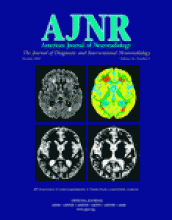We read with interest the paper by Gonzalez et al reporting their angiographic findings in 2 cases of intracranial aneurysms treated with bioactive coils (Matrix; Boston Scientific Corporation, San Jose, CA) in the April 2005 issue of the AJNR (1). The authors describe a well-defined radiolucent gap between the coil mass and the parent artery of the treated aneurysm, an angiographic finding they name the “white-collar sign.” They speculate that this finding results from the formation of a thick connective tissue barrier at the aneurysm neck, on the basis of a histopathologic study performed on an animal model (2). Gonzalez et al seem to suggest that this new angiographic finding is specific to intracranial aneurysms embolized with bioactive coils.
We wish to add a personal observation of a similar finding in a 53-year-old female patient treated in 2003 for a wide-necked aneurysm of the left internal carotid artery (clinoid segment; Fig 1A, -B). The aneurysm was embolized with 9 bare platinum coils (Trufill; Cordis Neurovascular, Miami, FL). Immediate postembolization angiography demonstrated obliteration of the aneurysm without residual neck. Follow-up angiography 11 months later confirmed complete obliteration of the aneurysm and demonstrated a radiolucent band separating the coil mass and the lumen of the parent artery, similar to the “white-collar sign” described by Gonzalez et al (Fig 1C, -D).
Our observation shows that, though bare platinum coils produce a lesser degree of histologic reaction than bioactive coils, the documentation of a radiolucent band separating the coil pack from the parent artery is not specific to the latter and can be observed with bare platinum coils as well. Although it is tempting to speculate that such a finding represents a favorable prognostic factor for the long-term follow-up of aneurysms treated with coils, its exact implication remains to be evaluated.
A 53-year-old female patient with an intracranial left internal carotid artery aneurysm.
A, Left internal carotid artery, 3D-digital subtraction angiography (DSA), oblique view, showing a paraophthalmic saccular aneurysm.
B, Left internal carotid artery, 3D-DSA, 2D reconstruction across the aneurysm sac and neck, showing the measurements of the aneurysm (height = 11.2 mm; length = 8.3 mm; neck = 5.8 mm).
C, Left internal carotid artery, DSA, subtracted oblique view of the follow-up angiogram obtained 11 months after treatment, confirming complete obliteration of the aneurysm sac.
D, Left internal carotid artery, DSA, unsubtracted oblique view (same view as C), showing a translucent separation between the coil mass and the parent artery.
- Copyright © American Society of Neuroradiology













